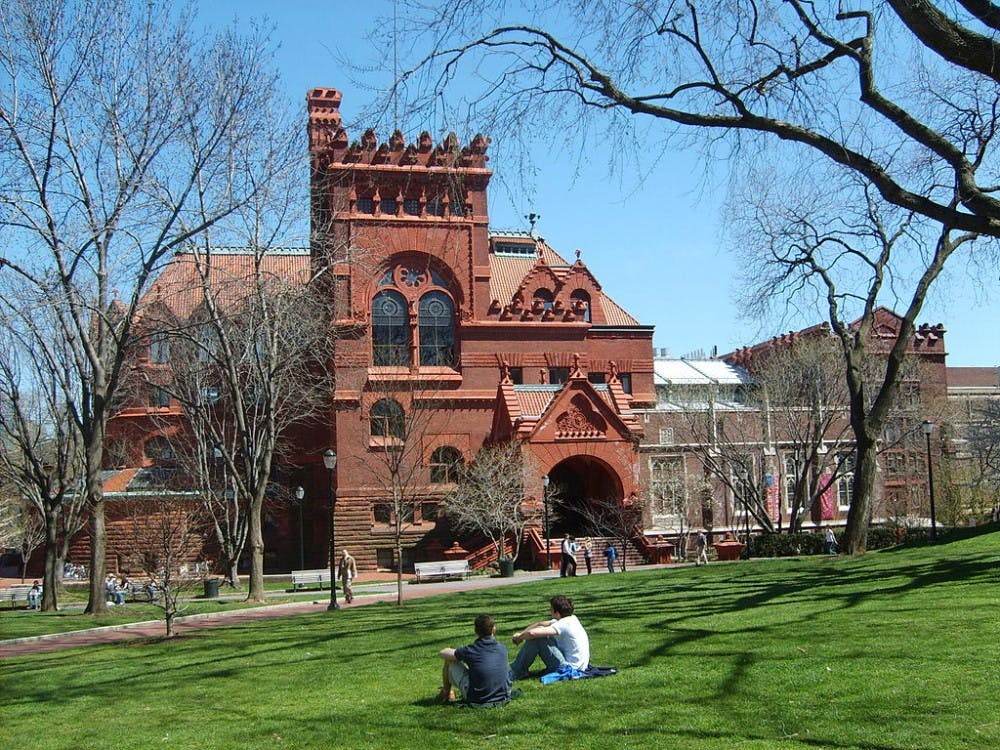Until December 10th, the Arthur Ross Gallery in Fisher Fine Arts is home to A View of One’s Own: Three Women Photographers in Rome, a traveling photo exhibit from the American Academy in Rome that showcases the talent of, as the name suggests, three women photographers in Rome.
The exhibit consists of three photographs—each by a different woman of a different generation. First is Columns of the Temple of Mars Ultor and the So-Called Arco dei Pantani Rome, taken in 1903 by archaeologist Esther Boise van Deman, who focuses her lens on the ruins of the Roman Forum from an aerial view. Fifty years later, Georgia Masson photographs the second piece, Piazza San Pierre Rome, a print from a negative of a palace in Rome from the early 17th century. The third piece, May 7th, 2014, is an archival pigment print taken on an iPhone by Jeannette Montgomery Barron of a few orange peels beneath a wall. The time lapse is a sped–up view of how Rome has evolved from the days of the Belle Époque to the modern day.
What makes this piece so important (aside from the artistic content) is the fact that the artists are women. Historically, women have lagged far behind men in the realm of documented photography as a consequence of the notion that women belonged in the kitchen. Independence, let alone creativity, was a far–fetched and absurd idea. Because of this, this exhibit is significant in that it showcases the emergence of photography as an independent medium for a woman’s subjective expression of self and perspective.
-----------------
Inspired by the different perspectives of the women in this exhibit, the Arthur Ross Gallery invited Penn students to share their stories by submitting photographs of Philadelphia or Penn.
Lauren Altman (MFA ’18), after a trip to India where she visited a number of silk sari producers, noticed the absence of women in the garment industry. Sitting in her apartment on 21st and South, she looks at the suits in her closet—the suits of her mother, a worker’s compensation attorney who had passed away.
“I’m looking at the suits in my closet, and I’m thinking about making visible the women in the garment industry.” And so came In Memory of Women’s Work. Taken in her bedroom, the piece is of Lauren’s reflection through a mirror in her mother’s suit. The clothing is visible, but she—like so many women in the industry—is turned away, invisible to the public eye, but surely there.
For some other students featured in the exhibit, their work is an exploration and appreciation of Philadelphia. Cari Krol (Penn Design ’19), in her piece Untitled, one in a series of 30, studies the interaction between people and the city—without people. Her series, set in West Poplar, captures the remnants we leave behind indicative of our presence, whether that be trash, graffiti, or clothing. Each photograph peels back a different layer of the city, documenting our relationship with our community.
Like Cari, Andy Nguyen (C ’20) looks at the city of Philadelphia and its beauty in his piece. Sitting on the 43rd floor of the Comcast building where he works, he is eating his Wawa sandwich when he looks out the floor–to–ceiling window. It’s the usual view: One Liberty Place and Two Liberty Place, two of the tallest buildings in the city. But today, he is enraptured by just how vast and beautiful Philadelphia is; the blue sky blankets a flurry of marshmallow white clouds, its continuity pierced only by the two skyscrapers that overlook the rest of the city. From there, with his iPhone 7 Plus, he takes Liberty in the Sky. He “didn’t put much thought into it; it was kind of an impromptu thing,” he says. It’s a perspective that encapsulates Philadelphia as a city.
So take a look around you. Look through your camera roll. Whether it be an empty coffee cup on the ground or an embarrassing solo mirror pic of you, each detail is a detail that makes up you and your environment.

